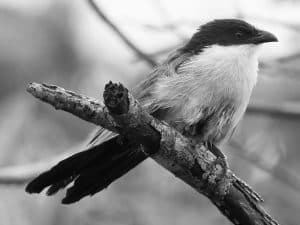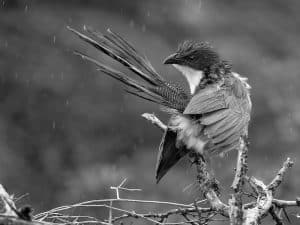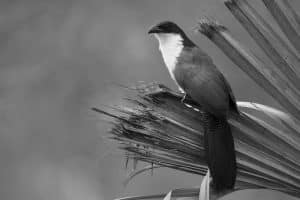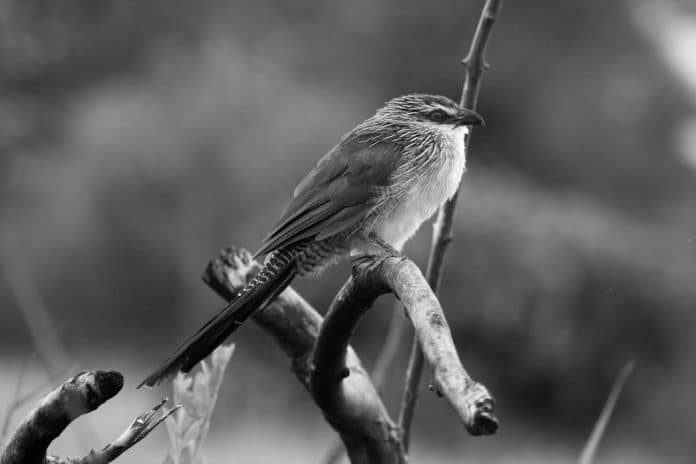Introduction to the white-browed coucal
The white-browed coucal is a fascinating bird species that can be found in Tanzania, a country renowned for its diverse wildlife and stunning landscapes. This bird, known for its subtle beauty and unique features, is a delight to observe in its natural habitat. In this article, we will explore the habitat and distribution of the white-browed coucal in Tanzania, its physical characteristics, behavior and mating habits, as well as the threats it faces and the conservation efforts in place to protect it.
Habitat and distribution of the white-browed coucal in Tanzania

The white-browed coucal is primarily found in the wetlands and marshes of Tanzania. These areas provide the perfect habitat for this bird, as they are abundant in reeds and tall grasses, which the white-browed coucal uses for nesting and foraging. This species is especially prevalent in the eastern and southern regions of Tanzania, including the wetlands of the Selous Game Reserve and the Rufiji River.
Physical characteristics and unique features of the white-browed coucal
The white-browed coucal is a medium-sized bird, measuring around 45-50 centimeters in length. It has a distinctive appearance, with its long, downward-curving tail and reddish-brown plumage. The most striking feature of this bird is its white eyebrow, which contrasts beautifully with its dark facial markings. Additionally, the white-browed coucal has a stout bill and strong legs, which enable it to navigate through the dense reeds and grasses of its habitat with ease.
Behavior and mating habits of the white-browed coucal
The white-browed coucal is known for its secretive nature, often hiding within the reeds and remaining unseen for long periods of time. Despite this, its unique call can be heard echoing through the wetlands, especially during the breeding season. During courtship, the male performs an elaborate display, spreading its tail feathers and hopping from one reed to another to attract a mate. Once paired, the couple collaborates in building a large, domed nest made of intertwined reeds. The female lays her eggs within this nest, and both parents take turns incubating them and caring for the chicks.
Threats and conservation efforts for the white-browed coucal in Tanzania

The white-browed coucal, like many other bird species, faces threats to its survival. Habitat loss due to human activities, such as agriculture and infrastructure development, poses a significant risk to the bird’s population. Additionally, pollution and the introduction of invasive species further impact its habitat and food sources. Fortunately, there are conservation efforts in place to protect the white-browed coucal and its wetland habitat in Tanzania. Organizations and wildlife reserves work together to raise awareness, conduct research, and implement conservation strategies to mitigate the threats faced by this species.
Tips for spotting and photographing the white-browed coucal in Tanzania
Spotting and photographing the white-browed coucal can be a rewarding experience for bird enthusiasts and wildlife photographers visiting Tanzania. To increase your chances of sighting this elusive bird, head to wetland areas such as the Selous Game Reserve and the Rufiji River. Move slowly and quietly, keeping an eye out for any movement or the distinct call of the white-browed coucal. Be patient and observant, as these birds often camouflage themselves amidst the reeds. When photographing, use a telephoto lens to capture the details of their plumage and unique features. Remember to respect their habitat and maintain a safe distance to avoid disturbance.
Other bird species found in the same habitat as the white-browed coucal
The wetlands and marshes that serve as the habitat for the white-browed coucal are home to a diverse array of bird species. Some of the notable birds found in the same habitat include the African jacana, purple heron, malachite kingfisher, and pied kingfisher. These birds coexist in harmony, each playing a vital role in maintaining the delicate balance of the ecosystem. Observing the interactions between these species can provide valuable insights into the interconnectedness of nature.
The importance of ecotourism in protecting the white-browed coucal and its habitat

Ecotourism plays a crucial role in protecting the white-browed coucal and its habitat in Tanzania. By promoting responsible and sustainable tourism practices, ecotourism ensures that visitors can enjoy the beauty of this bird species while minimizing negative impacts on the environment. Revenue generated from ecotourism can be used to fund conservation efforts, support local communities, and raise awareness about the importance of preserving the wetlands and the biodiversity they support. By participating in ecotourism activities, visitors contribute directly to the conservation of the white-browed coucal and help secure its future.
Recommended wildlife reserves and parks for observing the white-browed coucal in Tanzania
If you’re planning a trip to Tanzania and would like to observe the white-browed coucal, there are several wildlife reserves and parks that offer excellent opportunities for birdwatching. The Selous Game Reserve, one of the largest protected areas in Africa, is a prime location to spot this species. The Rufiji River, which flows through the reserve, provides an ideal habitat for the white-browed coucal. Other recommended locations include the Mahale Mountains National Park, the Serengeti National Park, and the Ngorongoro Conservation Area. These areas boast not only the white-browed coucal but also a wide range of other bird and wildlife species.
Conclusion: Appreciating the beauty and conservation of the white-browed coucal in Tanzania
In conclusion, the white-browed coucal is a subtle beauty among the reeds of Tanzania’s wetlands. Its unique physical characteristics, secretive behavior, and captivating mating rituals make it a fascinating bird species to observe. However, the white-browed coucal faces threats to its survival, making conservation efforts crucial. By appreciating the beauty of this bird and supporting ecotourism initiatives, we can contribute to its preservation and ensure that future generations can also marvel at the subtle elegance of the white-browed coucal in Tanzania.

































